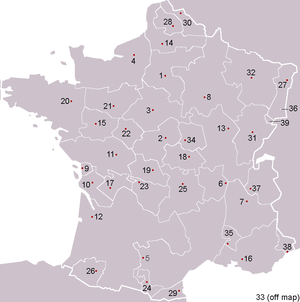Avignon
Avignon (UK: /ˈævɪnjɒ̃/, US: /ˌævɪnˈjoʊn/,[2][3][4] French: [aviɲɔ̃] (![]()
Avignon | |
|---|---|
Prefecture and commune | |
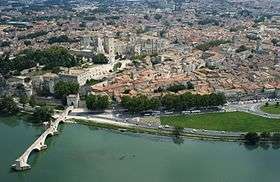 .jpg) .jpg)   .jpg) From top: Skyline, Rocher des Doms, Palais des Papes, Avignon Cathedral, Festival d'Avignon, Pont Saint-Bénézet | |
.svg.png) Coat of arms | |
Location of Avignon 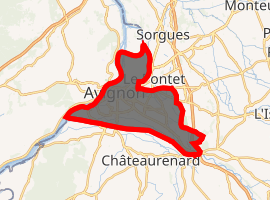
| |
 Avignon  Avignon | |
| Coordinates: 43°57′N 4°49′E | |
| Country | France |
| Region | Provence-Alpes-Côte d'Azur |
| Department | Vaucluse |
| Arrondissement | Avignon |
| Canton | Avignon-1, Avignon-2, Avignon-3 |
| Intercommunality | CA Grand Avignon |
| Government | |
| • Mayor (2014–2020) | Cécile Helle (PS) |
| Area 1 | 64.78 km2 (25.01 sq mi) |
| Population (2017-01-01)[1] | 91,921 |
| • Density | 1,400/km2 (3,700/sq mi) |
| Time zone | UTC+01:00 (CET) |
| • Summer (DST) | UTC+02:00 (CEST) |
| INSEE/Postal code | 84007 /84000 |
| Elevation | 10–122 m (33–400 ft) (avg. 23 m or 75 ft) |
| Official name | Historic Centre of Avignon: Papal Palace, Episcopal Ensemble and Avignon Bridge |
| Criteria | Cultural: i, ii, iv |
| Reference | 228 |
| Inscription | 1995 (19th session) |
| Area | 8.2 ha |
| 1 French Land Register data, which excludes lakes, ponds, glaciers > 1 km2 (0.386 sq mi or 247 acres) and river estuaries. | |
Between 1309 and 1377, during the Avignon Papacy, seven successive popes resided in Avignon and in 1348 Pope Clement VI bought the town from Joanna I of Naples. Papal control persisted until 1791 when, during the French Revolution, it became part of France. The town is now the capital of the Vaucluse department and one of the few French cities to have preserved its ramparts.
The historic centre, which includes the Palais des Papes, the cathedral, and the Pont d'Avignon, became a UNESCO World Heritage Site in 1995. The medieval monuments and the annual Festival d'Avignon have helped to make the town a major centre for tourism.
Toponymy
The earliest forms of the name were reported by the Greeks:[5] Аὐενιὼν Aueniṑn (Stephen of Byzantium, Strabo, IV, 1, 11) and Άουεννίων Aouenníōn (Ptolemy II, x).
The Roman name Avennĭo Cavărum (Mela, II, 575, Pliny III, 36), i.e. "Avignon of Cavares" accurately shows that Avignon was one of the three cities of the Celtic-Ligurian tribe of Cavares, along with Cavaillon and Orange.
The current name dates to a pre-Indo-European[5] or pre-Latin[6] theme ab-ên with the suffix -i-ōn(e).[5][6] This theme would be a hydronym – i.e. a name linked to the river (Rhône), but perhaps also an oronym of terrain (the Rocher des Doms).
The Auenion of the 1st century BC was Latinized to Avennĭo (or Avēnĭo), -ōnis in the 1st century and is written Avinhon in classic Occitan spelling[7] or Avignoun in Mistralian spelling.[8] The inhabitants of the commune are called avinhonencs or avignounen in both standard Occitan and Provençal dialect.
History
Geography
Avignon is on the left bank of the Rhône river, a few kilometres above its confluence with the Durance, about 580 km (360 mi) south-east of Paris, 229 km (142 mi) south of Lyon and 85 km (53 mi) north-north-west of Marseille. On the west it shares a border with the department of Gard and the communes of Villeneuve-lès-Avignon and Les Angles and to the south it borders the department of Bouches-du-Rhône and the communes of Barbentane, Rognonas, Châteaurenard, and Noves.
The city is in the vicinity of Orange (north), Nîmes, Montpellier (south-west), Arles (to the south), Salon-de-Provence, and Marseille (south-east). Directly contiguous to the east and north are the communes of Caumont-sur-Durance, Morières-lès-Avignon, Le Pontet, and Sorgues.
Geology and terrain
The region around Avignon is very rich in limestone which is used for building material. For example, the current ramparts, measuring 4,330 metres long, were built with the soft limestone abundant in the region called mollasse burdigalienne.[9]
Enclosed by the ramparts, the Rocher des Doms is a limestone elevation of urgonian type, 35 metres high[10] (and therefore safe from flooding of the Rhone which it overlooks) and is the original core of the city. Several limestone massifs are present around the commune (the Massif des Angles, Villeneuve-lès-Avignon, Alpilles...) and they are partly the result of the oceanisation of the Ligurian-Provençal basin following the migration of the Sardo-Corsican block.[9]
The other significant elevation in the commune is the Montfavet Hill – a wooded hill in the east of the commune.[9]
The Rhone Valley is an old alluvial zone: loose deposits cover much of the ground. It consists of sandy alluvium more or less coloured with pebbles consisting mainly of siliceous rocks. The islands in the Rhone, such as the Île de la Barthelasse, were created by the accumulation of alluvial deposits and also by the work of man. The relief is quite low despite the creation of mounds allowing local protection from flooding.[9]
In the land around the city there are clay, silt, sand, and limestone present.[9]
Hydrography
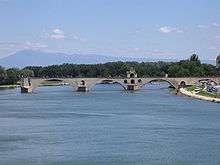
The Rhone passes the western edge of the city but is divided into two branches: the Petit Rhône, or "dead arm", for the part that passes next to Avignon and the Grand Rhône, or "live arm", for the western channel which passes Villeneuve-lès-Avignon in the Gard department. The two branches are separated by an island, the Île de la Barthelasse. The southernmost tip of the Île de la Barthelasse once formed of a separated island, the L'Île de Piot.[11]
The banks of the Rhone and the Île de la Barthelasse are often subject to flooding during autumn and March. The publication Floods in France since the 6th century until today – research and documentation[12] by Maurice Champion tells about a number of them (until 1862, the flood of 1856 was one of the largest, which destroyed part of the walls). They have never really stopped as shown by the floods in 1943–1944[13] and again on 23 January 1955[14] and remain important today – such as the floods of 2 December 2003.[15] As a result, a new risk mapping has been developed.
The Durance flows along the southern boundary of the commune into the Rhone and marks the departmental boundary with Bouches-du-Rhône.[16] It is a river that is considered "capricious" and once feared for its floods (it was once called the "3rd scourge of Provence"[lower-alpha 1] as well as for its low water: the Durance has both Alpine and Mediterranean morphology which is unusual.
There are many natural and artificial water lakes in the commune such as the Lake of Saint-Chamand east of the city.
Artificial diversions
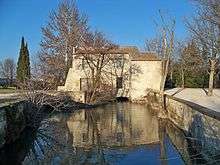
There have been many diversions[17] throughout the course of history, such as feeding the moat surrounding Avignon or irrigating crops.
In the 10th century part of the waters from the Sorgue d'Entraigues were diverted and today pass under the ramparts to enter the city. (See Sorgue). This watercourse is called the Vaucluse Canal but Avignon people still call it the Sorgue or Sorguette. It is visible in the city in the famous Rue des teinturiers (street of dyers). It fed the moat around the first ramparts then fed the moat on the newer eastern city walls (14th century). In the 13th century (under an Act signed in 1229) part of the waters of the Durance were diverted to increase the water available for the moats starting from Bonpas. This river was later called the Durançole. The Durançole fed the western moats of the city and was also used to irrigate crops at Montfavet. In the city these streams are often hidden beneath the streets and houses and are currently used to collect sewerage.
The Hospital Canal (joining the Durançole) and the Crillon Canal (1775) were dug to irrigate the territories of Montfavet, Pontet, and Vedène. They were divided into numerous "fioles" or "filioles" (in Provençal filhòlas or fiolo). Similarly, to irrigate the gardens of the wealthy south of Avignon, the Puy Canal was dug (1808). All of these canals took their water from the Durance. These canals were initially used to flood the land, which was very stony, to fertilize them by deposition of silt.
All of these canals have been used to operate many mills.
Seismicity
Under the new seismic zoning of France defined in Decree No. 2010-1255 of 22 October 2010 concerning the delimitation of the seismicity of the French territory and which entered into force on 1 May 2011, Avignon is located in an area of moderate seismicity. The previous zoning is shown below for reference.
"The cantons of Bonnieux, Apt, Cadenet, Cavaillon, and Pertuis are classified in zone Ib (low risk). All other cantons the Vaucluse department, including Avignon, are classified Ia (very low risk). This zoning is for exceptional seismicity resulting in the destruction of buildings.".[18]
The presence of faults in the limestone substrate shows that significant tectonic shift has caused earthquakes in different geological ages. The last major earthquake of significant magnitude was on 11 June 1909.[lower-alpha 2] It left a visible trace in the centre of the city since the bell tower of the Augustinians, which is surmounted by an ancient campanile of wrought iron, located in Rue Carreterie, remained slightly leaning as a result of this earthquake.
Climate
Avignon has a hot-summer mediterranean climate (Köppen climate classification: Csa), though the dry-summer effect is not as strong as coastal locations like Marseille due to its more sheltered inland location. With mild-cool winters and hot summers, with moderate rainfall year-round. July and August are the hottest months with average daily maximum temperatures of around 28 °C, and January and February the coldest with average daily maximum temperatures of around 9 °C. The wettest month is September, with a rain average of 102 millimetres, and the driest month is July, when the monthly average rainfall is 37 millimetres. The city is often subject to windy weather; the strongest wind is the mistral. A medieval Latin proverb said of the city: Avenie ventosa, sine vento venenosa, cum vento fastidiosa (Windy Avignon, pest-ridden when there is no wind, wind-pestered when there is).[19]
| Climate data for Avignon (1981–2010 averages, extremes 1958–present) | |||||||||||||
|---|---|---|---|---|---|---|---|---|---|---|---|---|---|
| Month | Jan | Feb | Mar | Apr | May | Jun | Jul | Aug | Sep | Oct | Nov | Dec | Year |
| Record high °C (°F) | 20.9 (69.6) |
22.3 (72.1) |
26.5 (79.7) |
31.1 (88.0) |
34.1 (93.4) |
42.8 (109.0) |
39.7 (103.5) |
40.5 (104.9) |
35.3 (95.5) |
30.8 (87.4) |
24.3 (75.7) |
21.0 (69.8) |
42.8 (109.0) |
| Average high °C (°F) | 10.2 (50.4) |
11.8 (53.2) |
15.6 (60.1) |
18.6 (65.5) |
23.1 (73.6) |
27.3 (81.1) |
30.7 (87.3) |
30.0 (86.0) |
25.3 (77.5) |
20.2 (68.4) |
14.0 (57.2) |
10.5 (50.9) |
19.8 (67.6) |
| Daily mean °C (°F) | 5.9 (42.6) |
7.1 (44.8) |
10.3 (50.5) |
13.1 (55.6) |
17.3 (63.1) |
21.2 (70.2) |
24.2 (75.6) |
23.7 (74.7) |
19.6 (67.3) |
15.4 (59.7) |
9.9 (49.8) |
6.6 (43.9) |
14.6 (58.3) |
| Average low °C (°F) | 1.6 (34.9) |
2.3 (36.1) |
5.1 (41.2) |
7.5 (45.5) |
11.4 (52.5) |
15.2 (59.4) |
17.8 (64.0) |
17.3 (63.1) |
14.0 (57.2) |
10.5 (50.9) |
5.8 (42.4) |
2.7 (36.9) |
9.3 (48.7) |
| Record low °C (°F) | −13 (9) |
−14 (7) |
−9.5 (14.9) |
−2.2 (28.0) |
1.3 (34.3) |
4.4 (39.9) |
8.6 (47.5) |
8.0 (46.4) |
3.9 (39.0) |
−2.2 (28.0) |
−7.4 (18.7) |
−14 (7) |
−14 (7) |
| Average precipitation mm (inches) | 48.7 (1.92) |
37.6 (1.48) |
38.6 (1.52) |
66.1 (2.60) |
62.5 (2.46) |
41.0 (1.61) |
26.6 (1.05) |
45.8 (1.80) |
97.6 (3.84) |
91.4 (3.60) |
71.1 (2.80) |
49.0 (1.93) |
676.0 (26.61) |
| Average precipitation days (≥ 1.0 mm) | 5.4 | 4.8 | 4.4 | 7.1 | 6.5 | 4.3 | 2.4 | 3.3 | 5.3 | 7.2 | 6.7 | 5.6 | 62.9 |
| Source: Météo France[20] | |||||||||||||
According to Météo-France the number of days per year with rain above 2.5 litres per square metre is 45 and the amount of water, rain and snow combined is 660 litres per square metre. Average temperatures vary between 0 and 30 °C depending on the season. The record temperature record since the existence of the weather station at Orange is 40.7 °C on 26 July 1983 and the record lowest was −14.5 °C on 2 February 1956.[21]
The mistral
The prevailing wind is the mistral for which the windspeed can be beyond 110 km/h. It blows between 120 and 160 days per year with an average speed of 90 km/h in gusts.[22] The following table shows the different speeds of the mistral recorded by Orange and Carpentras Serres stations in the southern Rhone valley and its frequency in 2006. Normal corresponds to the average of the last 53 years from Orange weather reports and that of the last 42 at Carpentras.[23]
Legend: "=" same as normal; "+" Higher than normal; "-" Lower than normal.
| Jan. | Feb. | Mar. | Apr. | May. | Jun. | Jul. | Aug. | Sep. | Oct. | Nov. | Dec. | |
|---|---|---|---|---|---|---|---|---|---|---|---|---|
| Maximum recorded speed by month | 106 km/h | 127 km/h | 119 km/h | 97 km/h | 94 km/h | 144 km/h | 90 km/h | 90 km/h | 90 km/h | 87 km/h | 91 km/h | 118 km/h |
| Tendency: Days with speed > 16 m/s (58 km/h) |
-- | +++ | --- | ++++ | ++++ | = | = | ++++ | + | --- | = | ++ |
Demographics
In 2010, the commune had 89,683 inhabitants. The evolution of the number of inhabitants is known from the population censuses conducted in the commune since 1793. From the 21st century, a census of communes with fewer than 10,000 inhabitants is held every five years, unlike larger communes that have a sample survey every year.
| 1793 | 1800 | 1806 | 1821 | 1831 | 1836 | 1841 | 1846 | 1851 |
|---|---|---|---|---|---|---|---|---|
| 24,000 | 21,412 | 23,789 | 29,407 | 29,889 | 31,786 | 33,844 | 35,169 | 35,890 |
| 1856 | 1861 | 1866 | 1872 | 1876 | 1881 | 1886 | 1891 | 1896 |
|---|---|---|---|---|---|---|---|---|
| 37,077 | 36,081 | 36,427 | 38,196 | 38,008 | 37,657 | 41,007 | 43,453 | 45,107 |
| 1901 | 1906 | 1911 | 1921 | 1926 | 1931 | 1936 | 1946 | 1954 |
|---|---|---|---|---|---|---|---|---|
| 46,896 | 48,312 | 49,304 | 48,177 | 51,685 | 57,228 | 59,472 | 60,053 | 62,768 |
| 1962 | 1968 | 1975 | 1982 | 1990 | 1999 | 2006 | 2010 | - |
|---|---|---|---|---|---|---|---|---|
| 72,717 | 86,096 | 90,786 | 89,132 | 86,939 | 85,935 | 90,800 | 89,683 | - |
Administration
Avignon is the prefecture (capital) of Vaucluse department in the Provence-Alpes-Côte-d'Azur region. It forms the core of the Grand Avignon metropolitan area (communauté d'agglomération), which comprises 15 communes on both sides of the river:[24]
- Les Angles, Pujaut, Rochefort-du-Gard, Sauveterre, Saze and Villeneuve-lès-Avignon in the Gard département;
- Avignon, Caumont-sur-Durance, Entraigues-sur-la-Sorgue, Jonquerettes, Morières-lès-Avignon, Le Pontet, Saint-Saturnin-lès-Avignon, Vedène and Velleron in the Vaucluse département.
List of Mayors
List of Successive Mayors[25]
| From | To | Name |
|---|---|---|
| 1790 | 1790 | Jean-Baptiste d'Armand |
| 1790 | 1791 | Antoine Agricol Richard |
| 1791 | 1792 | Levieux-Laverne |
| 1792 | 1793 | Jean-Ettienne Duprat |
| 1793 | 1793 | Jean-André Cartoux |
| 1793 | 1793 | Jean-François ROCHETIN |
| 1795 | 1795 | Guillaume François Ignace Puy |
| 1795 | 1796 | Alexis Bruny |
| 1796 | 1796 | Père Minvielle |
| 1796 | 1797 | Faulcon |
| 1797 | 1798 | Père Minvielle |
| 1798 | 1799 | Cadet Garrigan |
| 1799 | 1800 | Père Niel |
| 1800 | 1806 | Guillaume François Ignace PUY |
| 1806 | 1811 | Agricol Joseph Xavier Bertrand |
| 1811 | 1815 | Guillaume François Ignace Puy |
| 1815 | 1815 | Hippolyte Roque de Saint-Pregnan |
| 1815 | 1819 | Charles de Camis-Lezan |
| 1819 | 1820 | Louis Duplessis de Pouzilhac |
| 1820 | 1826 | Charles Soullier |
| 1826 | 1830 | Louis Pertuis de Montfaucon |
| 1830 | 1832 | François Jillian |
| 1832 | 1833 | Balthazar Delorme |
| 1834 | 1837 | Hippolyte Roque de Saint-Pregnan |
| 1837 | 1841 | Dominique Geoffroy |
| 1841 | 1843 | Albert d'Olivier de Pezet |
| 1843 | 1847 | Eugène Poncet |
| 1847 | 1848 | Hyacinthe Chauffard |
| 1848 | 1848 | Alphonse Gent |
| 1848 | 1848 | Frédéric Granier |
| 1848 | 1850 | Gabriel Vinay |
| 1850 | 1852 | Martial BOSSE |
| 1852 | 1853 | Eugène Poncet |
| 1853 | 1865 | Paul Pamard |
| 1865 | 1870 | Paul Poncet |
| 1870 | 1871 | Paul Bourges |
| 1871 | 1874 | Paul Poncet |
| 1874 | 1878 | Roger du Demaine |
| 1878 | 1881 | Paul Poncet |
| 1881 | 1881 | Eugène Millo |
| 1881 | 1884 | Charles Deville |
| 1884 | 1888 | Paul Poncet |
| 1888 | 1903 | Gaston Pourquery de Boisserin |
| 1903 | 1904 | Alexandre Dibon |
| 1904 | 1910 | Henri Guigou |
| 1910 | 1919 | Louis Valayer |
| 1919 | 1925 | Ferdinand Bec |
| 1925 | 1928 | Louis Gros |
| 1929 | 1940 | Louis Nouveau |
- Mayors from 1940
| From | To | Name | Party | Position |
|---|---|---|---|---|
| 1940 | 1942 | Jean Gauger | ||
| 1942 | 1944 | Edmond Pailheret | ||
| 1944 | 1945 | Louis Gros | ||
| 1945 | 1947 | Georges Pons | ||
| 1947 | 1948 | Paul Rouvier | ||
| 1948 | 1950 | Henri Mazo | ||
| 1950 | 1953 | Noël Hermitte | ||
| 1953 | 1958 | Edouard Daladier | ||
| 1958 | 1983 | Henri Duffaut | PS | |
| 1983 | 1989 | Jean-Pierre Roux | RPR | |
| 1989 | 1995 | Guy Ravier | PS | |
| 1995 | 2014 | Marie-José Roig | UMP | |
| 2014 | 2020 | Cécile Helle | PS |
(Not all data is known)
Twin towns - sister cities
Avignon is twinned with:[26]








Economy
Avignon is the seat of the Chamber of Commerce and Industry of Vaucluse which manages the Avignon – Caumont Airport and the Avignon-Le Pontet Docks.
Avignon has 7,000 businesses, 1,550 associations, 1,764 shops, and 1,305 service providers.[29] The urban area has one of the largest catchment areas in Europe with more than 300,000 square metres of retail space and 469 m2 per thousand population against 270 on average in France.[30] The commercial area of Avignon Nord is one of the largest in Europe.[31]
The tertiary sector is the most dynamic in the department by far on the basis of the significant production of early fruit and vegetables in Vaucluse, The MIN (Market of National Importance) has become the pivotal hub of commercial activity in the department, taking precedence over other local markets (including that of Carpentras).
A Sensitive urban zone was created for companies wanting to relocate with exemptions from tax and social issues.[32] It is located south of Avignon between the city walls and the Durance located in the districts of Croix Rouge, Monclar, Saint-Chamand, and La Rocade.[33]
Areas of economic activity
There are nine main areas of economic activity in Avignon.[34]
The Courtine area is the largest with nearly 300 businesses (of which roughly half are service establishments, one third are shops, and the rest related to industry) and more than 3,600 jobs.[34] The site covers an area of 300 hectares and is located south-west of the city at the TGV railway station.
Then comes the Fontcouverte area with a hundred establishments representing a thousand jobs. It is, however, more oriented towards shops than the Courtine area.[34]
The MIN area of Avignon is the Agroparc area[lower-alpha 3] (or "Technopole Agroparc"). The Cristole area is contiguous and both have a little less than a hundred establishments.[34]
Finally, the areas of Castelette, Croix de Noves, Realpanier, and the airport each have fewer than 25 establishments spread between service activities and shops. The area of the Castelette alone represents more than 600 jobs – i.e. 100 more than Cristole.[34]
Tourism
Four million visitors come annually to visit the city and the region and also for its festival.[29] In 2011 the most popular tourist attraction was the Palais des Papes with 572,972 paying visitors.[35] The annual Festival d'Avignon is the most important cultural event in the city. The official festival attracted 135,800 people in 2012.[35]
_001.jpg)
River tourism began in 1994 with three river boat-hotels. In 2011 there is a fleet of 21 river boat-hotel vessels, including six sight-seeing boats which are anchored on the quay along the Oulle walkways. In addition, a free shuttle boat connects Avignon to the Île de la Barthelasse and, as of 1987, a harbor master has managed all river traffic.
The commune has been awarded one flower by the National Council of Towns and Villages in Bloom in the Competition of cities and villages in Bloom.[36]
Agriculture
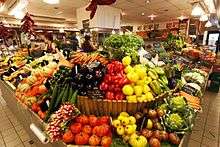
The city is the headquarters of the International Association of the Mediterranean tomato, the World Council of the tomato industry, and the Inter-Rhône organisation.
Industry
Only EDF (Grand Delta) with about 850 employees and Onet Propreté[lower-alpha 4] with just over 300 exceed 100 employees.[37]
Public sector (excluding government)
The Henri Duffaut hospital, the City of Avignon, and the CHS of Montfavet are the largest employers in the town with about 2,000 employees each. Then comes the General Council of Vaucluse with about 1,300 employees.[37]
Employment
In 2011 the unemployment rate was 15.6% while it was 13.7% in 2006.[38] There are 39,100 people in the Avignon workforce: 78 (0.2%) agricultural workers, 2,191 (5.6%) tradesmen, shopkeepers, and business managers, 4,945 (12.6%) managers and intellectuals, 8,875 (22.6%) middle managers, 12,257 (31.3%) employees, and 9,603 (24.6%) workers.[38]
Transport
Roads
Avignon is close to two highways:
- the A7 autoroute (E714) is a north-south axis on which there are two exits:


- the A9 autoroute (E15) which branches from the A7 near Orange along a north-east south-west axis towards Spain.
The main roads are:
- Route nationale N100 which goes west to Remoulins
- The D225 which goes north towards Entraigues-sur-la-Sorgue
- The D62 which goes north-east to Vedène
- The D28 which goes east to Saint-Saturnin-lès-Avignon
- The D901 which goes south-east to Morières-lès-Avignon
- Route nationale N570 which goes south to Rognonas
The city has nine paid parking buildings with a total of 7,100 parking spaces, parking buildings under surveillance with a capacity for 2,050 cars with a free shuttle to the city centre, as well as five other free parking areas with a capacity of 900 cars.[39]
Railways
Avignon is served by two railway stations: the historic train station built in 1860, the Gare d'Avignon-Centre, located just outside the city walls, which can accommodate any type of train and, since 2001, the Gare d'Avignon TGV in the "Courtine" district south of the city, on the LGV Méditerranée line. Since December 2013 the two stations have been connected by a link line – the Virgule. The Montfavet district, which was formerly a separate commune, also has a station.[40]
Airports
The Avignon - Caumont Airport on the south-eastern commune border has several international routes to England. The major airport in the region with domestic and international scheduled passenger service is the Marseille Provence Airport.
Water transport
The Rhône has for many centuries been an important means of transportation for the city. River traffic in Avignon has two commercial ports, docking stations for boat cruises, and various riverfront developments. A free shuttle boat has been established between the quay near the ramparts and the opposite bank (the île de la Barthelasse).
Public transport
The Transports en Commun de la Région d'Avignon, also known by the acronym TCRA, is the public transport operator for the commune of Avignon and its surrounding suburbs. TCRA operates bus services, as well as bike sharing and car pooling services. The first tram line opened in October 2019.[41][42]
Bicycles
Avignon has 110 km (68 mi) of bicycle paths.[29] In 2009 the TCRA introduced a bicycle sharing system called the Vélopop'.[43]
Cultural heritage
Avignon has a very large number of sites and buildings (173) that are registered as historical monuments.[44]
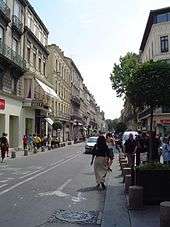
In the part of the city within the walls the buildings are old but in most areas they have been restored or reconstructed (such as the post office and the Lycée Frédéric Mistral).[45] The buildings along the main street, Rue de la République, date from the Second Empire (1852–70) with Haussmann façades and amenities around Place de l'Horloge (the central square), the neoclassical city hall, and the theatre district.

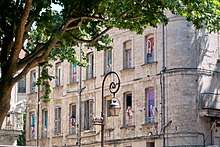
Listed below are the major sites of interest with those sites registered as historical monuments indicated:
- Notre Dame des Doms (12th century),


- Palais des Papes ("Papal Palace") (14th century)

- Minor churches of the town include, among others, three churches which were built in the Gothic architectural style:
- Civic buildings are represented most notably by:
- the Hôtel de Ville (city hall) (1846),

- the old Hôtel des Monnaies

- the Hôtel de Ville (city hall) (1846),
- The Ramparts,

- Bridges include:
- The Pont Saint-Bénézet, better known as the Pont d'Avignon and for the famous French song Sur le pont d'Avignon. Only four of the twenty one piers are left and the bridge ends mid-channel. On one of the piers stands the small Romanesque chapel of Saint-Bénézet.[55]
- The Pont Édouard Daladier and the Pont de Royaume, which together span both channels of the Rhone leading to Villeneuve-lès-Avignon, thus replacing the Pont Saint-Bénézet
- The Pont de l'Europe, which provides a second road crossing over the Rhone.
- Two railway bridges over the Rhone, one carrying the conventional Paris–Marseille line and the other the LGV Méditerranée line
- Calvet Museum, so named after Esprit Calvet, a physician who in 1810 left his collections to the town. It has a large collection of paintings, metalwork and other objects. The library has over 140,000 volumes.[56]
- The town has a Statue of Jean Althen, who migrated from Persia and in 1765 introduced the culture of the madder plant, which long formed the staple—and is still an important tool—of the local cloth trade in the area.
- Musée du Petit Palais (opened 1976) at the end of the square overlooked by the Palais des Papes, has an exceptional collection of Renaissance paintings of the Avignon school as well as from Italy, which reunites many "primitives" from the collection of Giampietro Campana.
- The Hotel d'Europe, one of the oldest hotels in France, in business since 1799.
- The Collection Lambert, houses contemporary art exhibitions
- The Musée Angladon exhibits the paintings of a private collector who created the museum
- Musée Lapidaire, with collections of archaeological and medieval sculptures from the Fondation Calvet in the old chapel of the Jesuit College.
- Musée Louis-Vouland
- Musée Requien
- Palais du Roure

- Les Halles is a large indoor market that offers fresh produce, meats, and fish along with a variety of other goods.
- The Place Pie is a small square near Place de l'Horloge where you can partake in an afternoon coffee on the outdoor terraces or enjoy a night on the town later in the evening as the square fills with young people.
- Note: the name of Pablo Picasso's 1907 painting Les Demoiselles d'Avignon (The Young Ladies of Avignon) is misleading; Picasso's models for this painting were in fact not women of the city of Avignon, but rather of the Carrer d'Avinyó (Avignon Street) in Barcelona.
Religious historical objects
The commune houses an extremely large number of religious items which are listed as historical objects. To see a comprehensive list of objects in each location click on the numbers in the table below:
Locations of Historical Objects
| Location | No. of Objects |
|---|---|
| Cathedral of Notre-Dame des Doms | 268 objects |
| Chapel of the Oratory | 1 object |
| Chapel of the White penitents | 5 objects |
| Chapel of the Grey penitents | 3 objects |
| Chapel of the Black penitents | 9 objects |
| Chapel of the Grand Seminary | 1 object |
| College of Saint-Joseph | 3 objects |
| Hospice of Saint-Louis | 1 object |
| Hospital Sainte-Marthe | 26 objects |
| Hotel of Saint-Priest d'Urgel (Hotel de Monery) | 27 objects |
| House of King René | 1 object |
| Calvet Museum | 3 objects |
| Arch-episcopal Palace | 1 object |
| Palais des Papes | 3 objects |
| Synagogue | 4 objects |
| Church of Saint-Agricol | 43 objects |
| Church of Saint-Didier | 21 objects |
| Church of Saint-Pierre | 23 objects |
| Church of Saint-Symphorien | 12 objects |
| Church of Montfavet | 4 objects |
| Total Objects | 459 |
Picture gallery
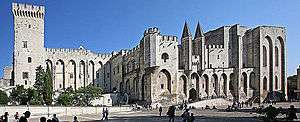 View of the Palais des papes from the square on the western side.
View of the Palais des papes from the square on the western side.- The Abbey of Saint-Ruf.
 The Pont d'Avignon famous from the song Sur le Pont d'Avignon.
The Pont d'Avignon famous from the song Sur le Pont d'Avignon. The Ramparts of Avignon.
The Ramparts of Avignon.- The Hôtel des Monnaies.
Culture
Avignon Festival
A famous theatre festival is held annually in Avignon. Founded in 1947, the Avignon Festival comprises traditional theatrical events as well as other art forms such as dance, music, and cinema, making good use of the town's historical monuments. Every summer approximately 100,000 people attend the festival.[58] There are really two festivals that take place: the more formal "Festival In", which presents plays inside the Palace of the Popes and the more bohemian "Festival Off", which is known for its presentation of largely undiscovered plays and street performances.
Avignon festival was founded by Jean Vilar. This cultural initiative brought, year after year, a major economic boost to the city and to the region of Provence. Indeed, the tourists visiting Avignon during the month of July usually take benefit of their presence to go to the smaller villages around, to discover the local food, local wines, touristic activities, learn some French.
The International Congress Centre
The centre was created in 1976 within the premises of the Palace of the Popes and hosts many events throughout the entire year. The Congress Centre, designed for conventions, seminars, and meetings for 10 to 550 persons, now occupies two wings of the Popes' Palace.[59]
"Sur le Pont d'Avignon"
Avignon is commemorated by the French song, "Sur le Pont d'Avignon" ("On the bridge of Avignon"), which describes folk dancing. The song dates from the mid-19th century when Adolphe Adam included it in the Opéra comique Le Sourd ou l'Auberge Pleine which was first performed in Paris in 1853. The opera was an adaptation of the 1790 comedy by Desforges.[60]
The bridge of the song is the Pont Saint-Bénézet over the Rhône of which only four arches (out of the initial 22) now remain. A bridge across the Rhone was built between 1171 and 1185, with a length of some 900 m (2950 ft), but was destroyed during the siege of Avignon by Louis VIII of France in 1226. It was rebuilt but suffered frequent collapses during floods and had to be continually repaired. Several arches were already missing (and spanned by wooden sections) before the remainder was abandoned in 1669.[61]
Sport
Sporting Olympique Avignon is the local rugby league football team. During the 20th century it produced a number of French international representative players.
AC Arles-Avignon was a professional association football team. They competed in Ligue 2, after a season 2010–2011 competing in Ligue 1 and being relegated back down the following season and ultimately folding in 2016. They played at the Parc des Sports, which has a capacity of just over 17,000.
Education
The schools within the commune of Avignon are administered by the Académie d'Aix-Marseille. There are 26 state nursery schools (Écoles maternelles) for children up to 6, and 32 state primary schools (Écoles élémentaires) up to 11. There are also 4 private schools.[62]
University of Avignon
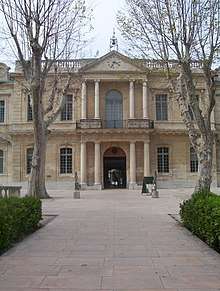
University before the Revolution
The medieval University of Avignon, formed from the existing schools of the city, was formally constituted in 1303 by Boniface VIII in a Papal Bull. Boniface VIII and King Charles II of Naples were the first great protectors and benefactors to the university. The Law department was the most important department covering both civil and ecclesiastical law. The law department existed nearly exclusively for some time after the university's formation and remained its most important department throughout its existence.[63]
In 1413 Pope XXIII founded the university's department of theology, which for quite some time had only a few students. It was not until the 16th and 17th centuries that the school developed a department of medicine. The bishop of Avignon was chancellor of the university from 1303 to 1475. After 1475 the bishop became an archbishop but remained chancellor of the university. The papal vice-legate, generally a bishop, represented the civil power (in this case the pope) and was chiefly a judicial officer who ranked higher than the Primicerius (Rector).[63]
The Primicerius was elected by the Doctors of Law. In 1503 the Doctors of Law had 4 Theologians and in 1784 two Doctors of Medicine added to their ranks. Since the Pope was the spiritual head and, after 1348, the temporal ruler of Avignon, he was able to have a great deal of influence in all university affairs. In 1413 John XXIII granted the university extensive special privileges, such as university jurisdiction and tax exempt status. Political, geographical, and educational circumstances in the latter part of the university's existence caused it to seek favour from Paris rather than Rome for protection. During the chaos of the French Revolution the university started to gradually disappear and, in 1792, the university was abandoned and closed.[63]
Modern university
A university annex of the Faculté des Sciences d'Aix-Marseille was opened in Avignon in 1963. Over the next 20 years various changes were made to the provision of tertiary education in the town until finally in 1984 the Université d'Avignon et des Pays de Vaucluse was created. This was nearly 200 years after the demise of the original Avignon university.[64] The main campus lies to the east of the city centre within the city ramparts. The university occupies the 18th century buildings of the Hôpital Sainte-Marthe. The main building has an elegant façade with a central portico. The right hand side was designed by Jean-Baptiste Franque and built between 1743 and 1745. Franque was assisted by his son François in the design of the portico. The hospital moved out in the 1980s and, after major works, the building opened for students in 1997.[65][66] In 2009–2010 there were 7,125 students registered at the university.[67]
Notable people
- Trophime Bigot, French painter, died in Avignon, 1650.[68]
- Jean Alesi, racing car driver, born in Avignon, 1964
- Henri Bosco, writer, born in Avignon, 1888.[69]
- Pierre Boulle, author of The Bridge over the River Kwai and Planet of the Apes, born in Avignon, 1912
- Alexandre de Rhodes (1591–1664), Jesuit missionary, born in Avignon.[70]
- Pierre-Esprit Radisson, fur trader and explorer, born in Avignon, 1636 or 1640
- Bernard Kouchner, politician, born in Avignon, 1936
- Albert Guille operatic tenor, born in Avignon, 1854
- Jean-Claude Malgoire, musician, born in Avignon in 1940
- Mireille Mathieu, singer, born in Avignon, 1946
- René Mey, spiritual leader
- Olivier Messiaen, composer, born in Avignon, 1908
- Joseph Vernet, painter, born in Avignon, 1714.[71]
- John Stuart Mill, liberal philosopher, died at Avignon in 1873 and is buried in the cemetery.[72]
- Dorothea von Rodde-Schlözer, artist and scholar, died in Avignon in 1825
- Michel Trinquier, painter, born in Avignon, 1930
- René Girard, historian, literary critic, philosopher, and author, born in Avignon, 1923
- Daniel Arsand, writer and publisher, born in Avignon, 1950
- Vincent Almendros, writer, winner of the 2015 prix Françoise Sagan, born in Avignon, 1978
- Cédric Carrasso, footballer, born in Avignon, 1981
- Charles Dumazer, hip-hop producer, professionally known as C-Sick, born in Avignon, 1991
- Benoit Paire, tennis player.
- Marianne-Agnès Falques, writer, born in Avignon, 1720
See also
- Avenir Club Avignonnais, a French association football team
- Battle of Avignon (737)
- Councils of Avignon, councils of the Roman Catholic Church
Notes
- Provençal tradition says that the first two were the mistral and the Parliament of Aix
- The épicentre was at Lambesc – a village in Bouches-du-Rhône.
- This area has had the INRA Centre which carries out scientific research in engineering environmental management for cultivated land and forests since 1953.
- Cleaning company.
References
- "Populations légales 2017". INSEE. Retrieved 6 January 2020.
- Wells, John C. (2008). Longman Pronunciation Dictionary (3rd ed.). Longman. ISBN 978-1-4058-8118-0.
- Jones, Daniel (2011). Roach, Peter; Setter, Jane; Esling, John (eds.). Cambridge English Pronouncing Dictionary (18th ed.). Cambridge University Press. ISBN 978-0-521-15255-6.
- "Avignon" (US) and {{Cite Oxford Dictionaries|Avignon|accessdate=16 May 2019}}
- Rostaing 1994, p. 30.
- Dauzat & Rostaing 1963, p. 1689.
- Robert Bourret (1999). French-Occitan Dictionary (in French and Occitan). Nîmes: Éd. Lacour. p. 59.
- Xavier de Fourvière & Rupert 1902, p. 62.
- Relief and Geology of the Avignon sector, Agence Rosier website (archived) (in French)
- Avignon Encyclopedia Universalis website (in French)
- "Cassini map circa 1750: Avignon". David Rumsey Historical Map Collection. Retrieved 31 July 2014.
- Champion 1862.
- Floods in Avignon, Institut national de l'audiovisuel video document, consulted on 19 July 2014 (in French)
- Floods in Paris and Avignon, 23 January 1955, Institut national de l'audiovisuel video document JT 20h, ORTF, consulted on 19 July 2014 (in French)
- Floods on 2 December 2003, Institut national de l'audiovisuel video document (in French)
- Watercourses: The Èze River (X31-0400), Sandre database (in French)
- The Street of Dyers – Avignon, avignon-et-provence.com website, consulted on 19 July 2014
- Regulatory Seismic Zoning of France, classed by cantons (as at the end of 1989) in the PACA rehion, p. 48. (in French)
- Mistral 1979, p. 196.
- "Avignon–INRA (84)" (PDF). Fiche Climatologique: Statistiques 1981–2010 et records (in French). Meteo France. Archived from the original (PDF) on 30 March 2018. Retrieved 29 March 2018.
- Infoclimat weather station at Orange (in French)
- Jean Vialar, Regional and local winds, 1948; reprinted by Météo-France in 2003. (in French)
- Source: Inter Rhône technical services at Avignon Metereological data from 2006 Archived 13 November 2008 at the Wayback Machine (in French)
- "Les communes". Communauté d'Agglomération du Grand Avignon. Retrieved 25 March 2014.
- List of Mayors of France (in French)
- "Jumelages". avignon.fr (in French). Avignon. Retrieved 12 November 2019.
- "Des villages de Cassini aux communes d'aujourd'hui: Avignon". École des hautes études en sciences sociales (EHESS). Retrieved 26 July 2014..
- Avignon, Town Hall Annual, consulted on 10 September 2010 (in French)
- "Contexte économique: Carte d'identité d'Avignon" (in French). Le Marie, Avignon.
- A wall of commercial areas, journal le Ravi, November 2008 (in French)
- It is the zone, article in the Provençal magazine le Ravi, September 2011
- The exemptions in the Sensitive urban zone of Avignon (in French)
- Maps and plans of the Sensitive urban zone of Avignon, Chamber of Commerce and Industry of Vaucluse, consulted on 19 October 2011 (in French)
- Principal areas of activity in the department, Chamber of Commerce and Industry of Vaucluse, consulted on 19 October 2011 (in French)
- Joly, Sylvie. "Avignon 2013: Dossier de Presse" (PDF) (in French). Office de Tourisme, Avignon. Archived from the original (PDF) on 10 August 2014. Retrieved 31 July 2014.
- Avignon in the Competition for Towns and Villages in Bloom Archived 10 December 2014 at the Wayback Machine (in French)
- South INSEE the highest 10, October 1998, INSEE, consulted on 18 October 2011 (in French)
- Key Employment data, INSEE
- "Transport: Parking" (in French). La Marie d'Avignon. Archived from the original on 26 September 2011. Retrieved 26 July 2014.
- "Transport: Le train". La Marie d'Avignon. Retrieved 26 July 2014.
- "TCRA Transports en Commun Région d'Avignon: Page d'accueil". Transports en Commun de la Région d'Avignon. Retrieved 26 July 2014.
- "Le tramway: Un projet optimisé pour 2016". Communauté d'Agglomération du Grand Avignon. Archived from the original on 2 July 2013. Retrieved 12 March 2013.
- "Vélopop" (in French). Transports en Commun de la Région d'Avignon. Retrieved 26 July 2014.
- "Search for "Avignon" in Mérimée database" (in French). Ministère de la Culture et de la Communication. Retrieved 26 July 2014.
- "L'extension du XXe siècle" (in French). Archives Municipales Avignon. Archived from the original on 17 January 2012. Retrieved 26 July 2014.
- Ministry of Culture, Mérimée PA00081814 Notre Dame des Doms (in French)

- Ministry of Culture, Palissy PM84000105 Tomb of Pope John XXII (in French)

- Ministry of Culture, Mérimée PA00081941 Palais des Papes (in French)

- Ministry of Culture, Mérimée PA00081834 Church of Saint-Pierre (in French)

- Ministry of Culture, Mérimée PA00081832 Church of Saint-Didier (in French)

- Ministry of Culture, Mérimée PA00081831 Church of Saint-Agricol (in French)

- Ministry of Culture, Mérimée PA00081880 Hôtel de Ville (in French)

- Ministry of Culture, Mérimée PA00081864 Hôtel des Monnaies (in French)

- Ministry of Culture, Mérimée PA00081943 Ramparts (in French)

- Vella et al. 2013.
- Vingtain & Aujard-Catot 2001, pp. 84–87.
- Ministry of Culture, Mérimée PA00081942 Palais du Roure (in French)

- "Festival 2014". Retrieved 6 November 2013.
- "Popes' Palace". Palais-des-papes.com. Archived from the original on 7 January 2010. Retrieved 17 January 2010.
- Anonymous (6 February 1853), "Théatre Impérial de l'Opéra-Comique, Le Sourd ou l'Auberge pleine: Comédie en trois actes de Desforges, mélée de musique par Ad. Adam", Revue et gazette musicale de Paris: journal des artistes, des amateurs et des théâtres (in French), Paris, 20 (6): 42.
- Rouquette 1974, pp. 219–229.
- "Liste des écoles maternelles et primaires". Le Marie d'Avignon. Retrieved 2 August 2014.
- Herbermann, Charles, ed. (1913). "University of Avignon". Catholic Encyclopedia. New York: Robert Appleton Company.
- "Présentation: Histoire". Université d'Avignon et des Pays de Vaucluse. Archived from the original on 7 April 2014. Retrieved 5 April 2014.
- Vingtain & Aujard-Catot 2001, pp. 123–124.
- Girard 1958, pp. 306–307.
- "Présentation: Chiffres clés". Université d'Avignon et des Pays de Vaucluse. Archived from the original on 24 October 2007. Retrieved 5 April 2014.
- Boyer 1988, p. 356.
- Vitaglione 2000, p. 63.
- Herbermann, Charles, ed. (1913). "Alexandre De Rhodes". Catholic Encyclopedia. New York: Robert Appleton Company.
- "Claude-Joseph Vernet". National Gallery, London. Retrieved 5 April 2014.
- Girard 1958, p. 356.
Sources
- Boyer, Jean (1988). "The one and only Trophime Bigot". The Burlington Magazine. 130 (1022): 355–357. JSTOR 883417.CS1 maint: ref=harv (link)
- Champion, Maurice (1862). Les inondations en France depuis le VIe siècle jusqu'a nos jours (Volume 4) (in French). Paris: V. Dalmont.CS1 maint: ref=harv (link)
- Dauzat, Albert; Rostaing, Charles (1963). Dictionnaire étymologique des noms de lieux en France (in French). Paris: Larousse.CS1 maint: ref=harv (link)
- Girard, Joseph (1958). Évocation du Vieil Avignon (in French). Paris: Les Éditions de Minuit. OCLC 5391399.CS1 maint: ref=harv (link)
- Mistral, Frédéric (1979) [1879]. Lou Trésor dou Félibrige ou Dictionnaire provençal-français (Volume 1: A-F ) (in French and Occitan). Raphèle-lès-Arles: M. Petit.CS1 maint: ref=harv (link)
- Rouquette, Jean-Maurice (1974). Provence Romane: La Provence Rhodanienne (in French, English, and German). Paris: Zodiaque. OCLC 1036957.CS1 maint: ref=harv (link)
- Rostaing, Charles (1994) [1950]. Essai sur la toponymie de la Provence : depuis les origines jusqu'aux invasions barbares (in French). Marseille: Jeanne Laffitte. ISBN 978-273480676-9.CS1 maint: ref=harv (link)
- Vella, Marc-Antoine; et al. (2013). "Géoarchéologie du Rhône dans le secteur du pont Saint-Bénézet (Avignon, Provence, France) au cours de la seconde moitié du deuxième millénaire apr. J.-C. : étude croisée de géographie historique et des paléoenvironnements" (PDF). Géomorphologie : relief, processus, environnement (in French and English). 3: 287–310. doi:10.4000/geomorphologie.10300.
- Vingtain, Dominique; Aujard-Catot, Roland, eds. (2001). Avignon: Musées, Monuments, Promenades (in French). Paris: Éditions du patrimoine. ISBN 2-85822-555-9.CS1 maint: ref=harv (link)
- Vitaglione, Daniel (2000). The Literature of Provence: An Introduction. Jefferson, North Carolina: McFarland. ISBN 9780786408436.CS1 maint: ref=harv (link)
- Xavier de Fourvière, R.P.; Rupert, R.P. (1902). Lou pichot tresor, dictionnaire provençal-français et français-provençal. Avignon: Aubanel.CS1 maint: ref=harv (link)
- Herbermann, Charles, ed. (1913). . Catholic Encyclopedia. New York: Robert Appleton Company.
- Herbermann, Charles, ed. (1913). . Catholic Encyclopedia. New York: Robert Appleton Company.
- Herbermann, Charles, ed. (1913). . Catholic Encyclopedia. New York: Robert Appleton Company.
- Chisholm, Hugh, ed. (1911). . Encyclopædia Britannica (11th ed.). Cambridge University Press.
External links
| Wikimedia Commons has media related to Avignon. |
| Wikivoyage has a travel guide for Avignon. |
- Tourist office website
- City council website
- Avignon greater metropolitan area website (in French)
- Google Earth view of Avignon

